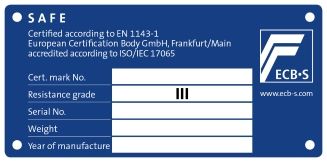European Standards EN 14450, EN 1143-1 and EN 1143-2


Any physical alterations to the unit such as the addition of a suction tube, capsule deposit, rotary deposit drum or envelope slot will make the EN1143 certification void for insurance purposes.
The only safe certification valid in the E.U. is that which has been awarded by a body that has accreditation according to EN45011, which has now been updated to the new ISO/IEC 17065:2012 standard.
EN Standards Related To Cabinets, Safes And Strong Rooms:
Secure cabinets. Grades S1 and S2
Free-standing safes, built-in safes (floor and wall), ATM safes and ATM bases, strongroom doors and strongrooms (with or without a door) according to their burglary resistance. This European Standard does not cover testing and classifying deposit systems. ATM is a totally different classification to safes. There is no physical attack test for ATM units at present.
Deposit systems, and classifies the systems according to their burglary resistance and their resistance to the theft of deposits. This EU Standard comprises two types of deposit system: – night safes and deposit safes.
High-security locks intended for safes and vaults are awarded a grade for burglary-resistance.
As They Relate To Overnight Insurance Cover
€2,500.00 – This is a “secure cabinet” classification
€5,000.00 – This is a “secure cabinet” classification
| Grade 0 – €7,500 Locks Required: 1 Lock Class: A |
Grade 1 – €12,500 Locks Required: 1 Lock Class: A |
Grade 2 – €25,000 Locks Required: 1 Lock Class: A |
| Grade 3 – €50,000 Locks Required: 1 Lock Class: B |
Grade 4 – €90,000 Locks Required: 2 Lock Class: B |
Grade 5 – €150,000 Locks Required: 2 Lock Class: B |
| Grade 6 – €200,000 Locks Required: 2 Lock Class: C |
Grade 7 – €375,000 Locks Required: 2 Lock Class: C |
Grade 8 – €600,000 Locks Required: 2 Lock Class: C |
| Grade 9 – €975,000 Locks Required: 2 Lock Class: C |
Grade 10 – €1.5M Locks Required: 2 Lock Class: C |
Grade 11 – €2.25M Locks Required: 2(3) Lock Class: D(C) |
| Grade 12 – €3.37M Locks Required: 2(3) Lock Class: D(C) |
Grade 13 – €5.25M Locks Required: 3 Lock Class: D |
Misrepresentation and Fraud
Misrepresentation and fraud are widespread in the safes and vault industry in Ireland.
- Second hand safes sold as new.
- Uncertified steel boxes sold as high security safes.
- Non-accredited "certification" bodies who "certify" products based on completely invalid criteria with no legal basis.
- Misleading terms like "Euro Grade" imply Euorpean certification while offering none.
- "Recommended cash covers" which are two, five or even ten times higher than what an insurer would ever pay out.
- DIY deposit systems which invalidate certification and insurance cover.
For overnight insurance purposes, safes are graded according to their tested resistance to attack. The testing must be done according to E.U. standards, by test houses accredited according to ISO/IEC 17025:2012 and then the rating itself must be certified by certification bodes holding ISO/IEC 17065:2012 accreditation. When a safe is tested according to European standards it has a test badge fixed to the inside of its door stating its grade in Roman numerals, its weight and its type.
- * IT IS FRAUD TO DO ANY OF THE FOLLOWING:
- Alter a certified safe for a deposit system and claim the altered product as a graded safe for insurance purposes.
- Claim a safe with unaccredited certification as a recognised grade safe accedited to European standard ISO/IEC 17065:2012.
- Claim a cash cover for a safe based on the "recommended cover" proposed by the manfacturer.
- Sell a safe that has been damaged due to being cut open after a lockout as a refurbished certified safe.
- Claim a certified fire cover where none has been certified.


